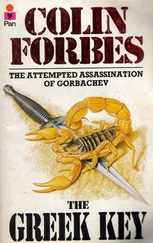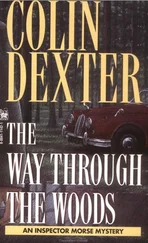As he directed the scudder to continue the descent, a sudden warning was issued by the observers on the work vessel. ‘ Look out below! You’re off course and running right into the path of the black hole.’
The pilot reacted before Fritz had time to formulate his instruction. Veering crazily away in a tight arc, the little spacecraft struggled to escape from the gravitational well of the black hole which was overtaking it from the rear. Unless they could build up to escape velocity they were liable to be dragged irrevocably down into this hole to end all holes.
For a short time it looked as though they might escape completely. Then the full power of the scudder’s tiny motors became insufficient to move them any farther against the intense gravitational attraction which now arrested and began to drag them back towards the surface. There was nothing the occupants could do except sit helpless as they were seized as if by a giant hand and thrown back on to the asteroid.
The touchdown, when it came, was unexpectedly mild. Fortunately their descent had been delayed by the scudder’s motors just long enough for the black hole to have sped on its uncaring way. The friction of the craft against the asteroid’s surface was sufficient to prevent them being drawn in the black hole’s wake. Almost immediately the gravitational spasm was over, and Negrav’s own negative gravity spun them crazily back into space.
Dazed and shaken, Van Noon checked his equipment, whilst the scudder pilot tested his craft. Miraculously there had been very little damage. The scudder, though dented, was still spaceworthy even though much of its instrumentation had failed. Van Noon’s precious package, which had been the reason for the descent, likewise appeared to have suffered no permanent harm.
His timing, however, had been completely destroyed. This was a factor beyond recovery. Because of the orbiting black hole, the packages which had already been placed on Negrav had only a limited life expectancy. If his own package was not now put in place, the existing ones would all be destroyed before any new calculations could be made.
Van Noon shrugged his shoulders and took a chance. He placed the package with its magnet pack on the nearest part of the surface, knowing that its position was far from being where he had originally intended. The results would be in the lap of the gods, but it was either this or make the long haul back to New Australia for a fresh set of supplies. Then tired and disconcerted, he ordered the scudder back to the ship.
Compared to this first trip, the rest of the journeys to Negrav seemed uneventful. No less than seven other trips followed some achieving the desired accuracy, others varying. There was no time left, however, to make any corrections. Fritz had to suffer the errors and hope against hope that some overseeing deity would bring the project through. Otherwise he shuddered to think of the final results.
Then came the final phase. One after another in controlled sequence great explosions flared upon the surface of Negrav; appearing as little more than pinpoints of light to the distant observers, yet in reality being ample charges of super-high explosive. The timing was accurate according to the original schedule, but because of misplacement of several of the charges, the net effect would be anything but optimum. There followed a long period of waiting, after which the remaining charges were fired.
As Van Noon read the final collation of results, his heart sank like a stone. He had arranged to check the orbital velocity of Negrav so that it fell into a lower orbit around the black hole. In effect this meant that for a number of rotations the black hole would actually orbit inside the surface of Negrav. Then he had planned to correct Negrav’s velocity so that the black hole would return to the surface leaving a toroidal cavity inside the asteroid’s equator. Probably due to misplacement of the charges, the scheme had gone disastrously wrong. The black hole had remained inside Negrav…
Stupefied, he read the figures, but they no longer registered in his brain. Instead he saw the asteroid of Negrav being progressively eaten from inside by a small black hole so voracious that it could consume its entire host without particularly noticing the meal. Worse, if it remained inside Negrav, the asteroid would disappear entirely. Van Noon did not much fancy being known for the rest of his career as the man who lost a whole asteroid.
In an agony of indecision, he called for the orbit of the asteroid to be monitored continuously, while he searched through the ship’s stocks hoping to find sufficient explosive to kick the asteroid’s velocity up and bring the black hole again to the outside. A trip to New Australia for fresh supplies was out of the question because of the time involved. By the time they returned, Negrav would have been swallowed whole.
He was unlucky. The explosives he had brought from New Australia had been carefully calculated for the job, and the entire stock had been used. Nor did the ship carry any stocks of its own. He briefly thought of trying to nudge the asteroid with the ship itself, but concluded that the vessel was unlikely to survive the ordeal.
Disconsolate, he sat down again to check the results of the orbital monitoring. As he did so, he began to brighten considerably. When Jacko found him, he was chuckling uncontrollably, and tears of laughter were streaming down his face.
‘You’re the first person I ever saw get a belly-laugh out of a computer printout,’ said Jacko warily. ‘We don’t have a strait-jacket, so I’d better give you a shot of tranquillizer. I’d advise you not to struggle.’
‘Knock it off, Jacko! I’ve just received proof of the theorem that the deserving don’t always get what they deserve. Alternatively, the unorthodox looks after its own.’
‘Crazy like two foxes!’
‘Look at these orbital figures, Jacko. And tell me what it was about the original problem we forgot.’
Jacko took the sheets of printout and looked through them wonderingly. Then he, too, began to smile.
‘Negrav’s speeding up. If it continues to do that, the black hole’ll come outside again of its own accord— and soon.’
‘Right! We forgot about conservation of momentum. As the black hole removes some of Negrav’s mass, the asteroid gets lighter but its initial momentum remains. Therefore it has to go faster, and climb into a higher orbit. It’s a self-stabilizing system because whenever the black hole removes some mass from the asteroid, Negrav itself automatically retreats from the attack.’
‘So what’re we left with? The same problem only with a slightly smaller Negrav?’
‘No. Unless my figures are wrong, the black hole’s been in there long enough to give us a concentric ball and shell effect—like a marble in a table-tennis ball. The increase in Negrav’s speed is running up an exponential curve, so that when the black hole does come out it should do so at some considerable angle. With luck it’ll only puncture the shell as it comes, not eat it away. And do you realize the implications of that, my boy?’
‘We were lucky?’ asked Jacko uncertainly.
‘Yes, but not only that. It means that Negrav will be safer from attack by the black hole than ever before. And if that cavity’s the size I think it is, they’ll be able to build a major base in there, not just an observatory. They can mine Leda at their leisure, and use Negrav as an on the spot refinery and transfer station from which they can load hyper ships direct. It’ll be the most valuable space facility on the Rim.’
As the figures had predicted, the black hole did come out of Negrav. It reappeared some thirty-two hours later and finally stabilized with an orbital separation of eleven kilometres. This new orbital distance was a measure of the amount of mass which had been removed from Negrav.
Читать дальше












